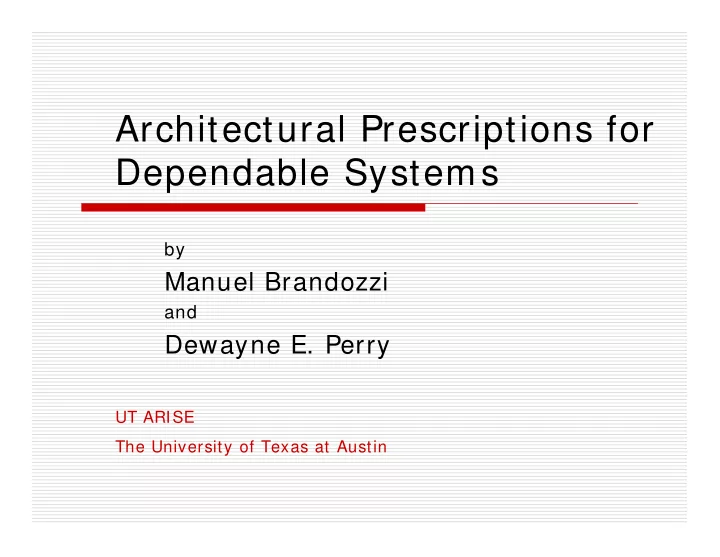

Architectural Prescriptions for Dependable Systems by Manuel Brandozzi and Dewayne E. Perry UT ARISE The University of Texas at Austin
Outline � Introduction to Architectural Prescriptions � Overview of Preskriptor and KAOS � Dependability and Prescriptions � Current and Future work
What is an Architectural Prescription? � It’s the architectural design of a system in terms of: The high level components � The properties of the components and their � interrelationships The constraints (expressed in the vocabulary of � the requirements) on the system’s components and on their interrelationships � An Architectural Prescription provides the very basic framework of the system to satisfy the requirements
Differences between a Prescription and a Description � A prescription makes the step from requirements to architecture easier to formalize and to perform � Problem domain vs. Solution domain � A prescription enables the use of new, innovative solutions � It enables a higher degree of reusability by fewer constraints on the solution space
KAOS � The domain is modeled as objects and operations � First the goals of the overall system (software, people, engines, etc.) are specified � Then these goals are refined till their sub-goals are assignable to some agents (requirements and assumptions)
Sample Preskriptor Component � Component StockValues [ 1,1] � Type Data � Constraints Maintain[ StoreStockValues] , Maintain[ AuthorizedAccessesOnly] , … � Composed of DB [ 1,1] , Server [ 1,1] � Uses MarketConnect to interact with StockMarket
The Preskriptor Process from requirements specification phase Root Goal(s) Step 1 Root Component(s) Step 2 KAOS Objects Potential Sub- component(s) Step 3 KAOS Goals Architectural Prescription feedback to requirements specification phase
The Preskriptor Process –cont. From Non Problem Domain From Step 3 specifications Architectural Goals Architectural Styles Problem Oriented Prescription Compatibility Goals Step 4 feedback to Step 3 Solution Oriented Prescription
Dependability Requirements � Non-functional requirements: reliability, performance, reusability, etc. � Effects: � Add new components � Transform existing topology � i.e. change interactions between components and/ or the components’ number of instances � Further constrain existing components
Types of Non-Functional Requirements (NFR) Additive NFR � Can be achieved by adding to the system new � components and their relationships to the existing components. They may also change the number of instances of the components already in the system. E.g.: fault tolerance � Separation NFR � Affect only a subset of the system identifiable by a � property E.g.: performance � Integral NFR � They either affect the whole system, or it’s not � possible to clearly identify the subsystem they affect E.g.: Dynamically reconfigurable � Can be achieved by: Dynamic reconfiguration style
ANFR example - before BankerClient 1 BankerClient 2 BankerClient 3 StockValuesAccess Stock Values MarketConnect StockMarket 1 StockMarket 2 Legend Processor Data Uses Connector
ANFR example - after BankerClient 1 BankerClient 2 BankerClient 3 StockValuesAccess StockValues 1 InterCopyCoordinator StockValues 2 StockValues 3 MarketConnect StockMarket 1 StockMarket 2 Legend Processor Data Uses Connector
Some Key Advantages of Our Methodology � Easiness � Conformance to requirements � Separation of concerns � Customization � Evolution � Reusability
Current and Future work � Validate our methodology with empirical studies � Find out ways to compositionally transform architectures to achieve the most common ANFRs � Develop a tool to guide and to automate parts of the requirements to prescription process
Recommend
More recommend